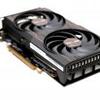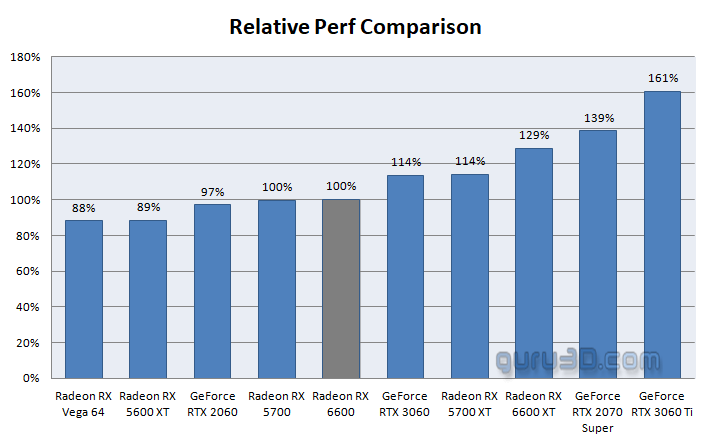Final words and conclusion
Final words
You know, if graphic cards weren't so horrendously costly these days, I'd even say that AMD had a compelling value proposition on its hands. With performance comparable to Radeon RX Vega 64 / 5700 cards and at RTX 2060 performance levels. With the added bonus of being Raytracing compatible, the 6600 really would have been a serious contender. In fact, for 1920x1080 and even 2560x1440 gaming, this card provides adequate performance across a wide range of games that have been tested. Of course, when Raytracing is enabled, the dynamic changes quickly due to the restricted GPU and very limited memory bus resources, which truly constitutes a bottleneck.
AMD ought to be commended for remaining committed to 8 GB graphics memory for this product series. Raw Raytracing performance is a notch slower than the competition offers and at times a little frustrating as the performance often isn't there. Albeit FSR is now available to help a little bit, we can also not apprehend that AMD still has not implemented any form of machine learning super-sampling dedicated in hardware, much like NVIDIA offers Tensor cores. For reasons like RT perf and lacking MLAA, we cast doubt on how AMD is justifying a starting price of 339 USD. You can also argue that while the 'infinity cache' read: L3 cache, works most of the time, it's designed to be a workaround to fill a shortcoming (128-bit memory bus) and the choice of a more affordable memory type (GDDR6 opposed to GDDR6X), the current AMD GPUs are very memory bandwidth deprived, even with GDDR6 at 14 Gbps, but more so due to the 128-bit wide memory bus. And that's going to come back to bite this product every time the GPU is overloaded or the 32MB L3 cache runs out of cache hit ability.
FidelityFX Super Resolution
DLSS is not a stranger to AMD they just have not been able to react to it adequately, as such they have been working on a technology known as FidelityFX Super-Resolution for some time. Despite the fact that AMD's supersampling and sharpening technology is currently available, the number of games that support it is extremely limited. As you can see, we tested this with Resident Evil, and the performance improvement was only marginally better than expected when combined with Raytracing. With far Cry 6 and FSR, it really helps out though has the best effect in higher resolutions, which this card was not at all designed for.
Reference card competitive performance spread
Consider the following comparison of various graphics cards in a particular price-performance range: Consider the table below to observe how the changes between the top and bottom are imperceptible.
If we look at the data in further detail, we can see something interesting. Specifically, AMD is aiming the 6600 against the GeForce RTX 2060 with a somewhat similar feature set (no DLSS though). As a result, the Radeon RX 6600 is, in our perspective, competitively priced with 2060, but really should have been performing closer to NVIDIA's regular 3060.
Cooling & acoustic
The Sapphire Radeon RX 6600 XT Pulse, like its larger brothers, delivers excellent performance even under demanding situations, thanks to the dual-fan cooling. If you try to hear the card, you'll have a difficult time. According to its default configuration, the GPU beneath the hood generates 120~130W of heat, suggesting that the cooler has a thermal power design of 175W. We're looking at 33 DBa values under load and temperatures in the 75 degree Celsius range. The temps run a bit high, but it's not something to worry about.
Energy
Heat output and energy consumption are closely related to each other, as (graphics) processors and heat can be perceived as a 1:1 state; 250 Watts in energy consumption approaches close to 250 Watts in heat as output. This is the basis of TDP. AMD is listing the card at 132W, which is okay in the year 2021. We measure numbers slightly under the advertised values; we measure the entire power consumption of the card to close in at 120 Watt.
Coil whine
Coil squeal is hardly present on the 6600, just as it is on any other card these days. Is it a bothersome annoyance? This type of noise would be muffled in a closed chassis and fade into the background. With an open chassis, on the other hand, you may hear coil whine/squeal. In some way or another, all graphics cards do this, especially when running at higher frame rates; this can be perceived.
Pricing
The 6600 is priced significantly higher than it should be (in our opinion) we have already discussed this extensively in the past year. AIB cards will almost certainly exceed the 350 USD level, which makes little sense for a product geared at the Full HD monitor market. We truly believe that this 339 USD device should cost no more than 229 USD at best.
Tweaking
The RX 6600 enjoys having more memory bandwidth available to it. You can add it manually and get up to its maximum configurable 15.2 Gbps; however, results will vary depending on the board, brand, and even card due to cooling (GDDR6/GPU/VRM) and other factors. With a little GPU tweaking, we could get this AMD Navi GPU to run at a very respectable 2700~2800 MHz. And that's without any anomalies or crashes of any kind. The dynamic clock frequency is now hovering in the ~2700 MHz range, depending on the load, game/app, and board assigned power. Even so, that's quite a feat. As is always the case, all of your tweaking and increased energy consumption will only provide you with a maximum of 5~7% improvement in performance (depending on your results and model graphics card). It must successfully complete four-game runs (in four different games) in 2560x1440 resolution in order to be considered stable enough to be listed here.
Conclusion
AMD's entry-level to mainstream offering is totally sound. However, the pricing is disturbing. As a product in its intended range, it's great though. AMD made memory subsystem design decisions that limited memory bandwidth; by including 32MB of L3 cache, AMD has circumvented the majority of this limitation, as such these cards perform flawlessly up to 1920x1080; however, L3 cache will always be a bypass, a short-cut to a problem that may recur in the future. Due to the severely constrained memory bus, performance will degrade immediately upon the cache running dry. While AMD's raytracing technology may not perform as well as its competitors, it is still useful for "fooling around a little." We feel that FSR will be insufficient for the majority of AAA titles to make a noticeable difference in this area, given 1080P is the card's gaming domain, and FSR performs better at higher resolutions. It must be said, though, that this is a fun choice to have and explore with. Performance-wise at Full HD, the card delivers without a doubt, making this a great gaming card series focused mostly on rasterized Full HD rendering; at and even beyond Full HD up to WQHD, the 32MB L3 cache works its witchery. You can play about with raytracing a little bit to see what occurs, but the render engine will quickly run out of stamina. None of that is even slightly important as the main factor remains pricing. The high asking price remains a significant problem, especially when product positioning and relative performance are considered. Other than that we'd like to add that Sapphire performed an amazing job with the design of the Pulse and handled everything correctly; you will obtain a graphics card that is silent, fashionable, and hip-looking. It did run slightly hotter than intended, however. While we cannot recommend the Radeon RX 6600 merely on the basis of its price, we can approve the device in its intended configuration. To be honest, we wished the performance of the 6600 product line would have been closer to that of the GeForce RTX 3060; that remains to be a legitimate point of criticism. But as an entry-level to mainstream card we also admit that it's not a bad one aside from the price level.
Sign up to receive a notification when we publish a new article.
Or go back to Guru3D's front page.
- Hilbert, LOAD"*",8,1.



